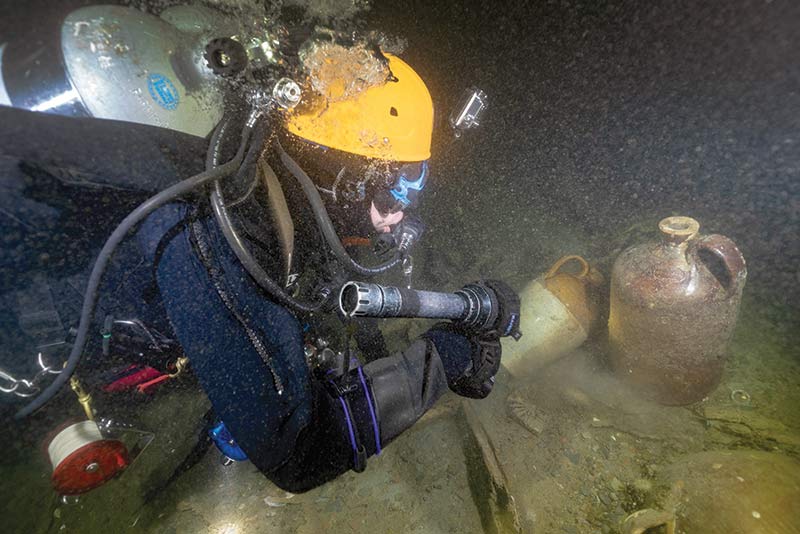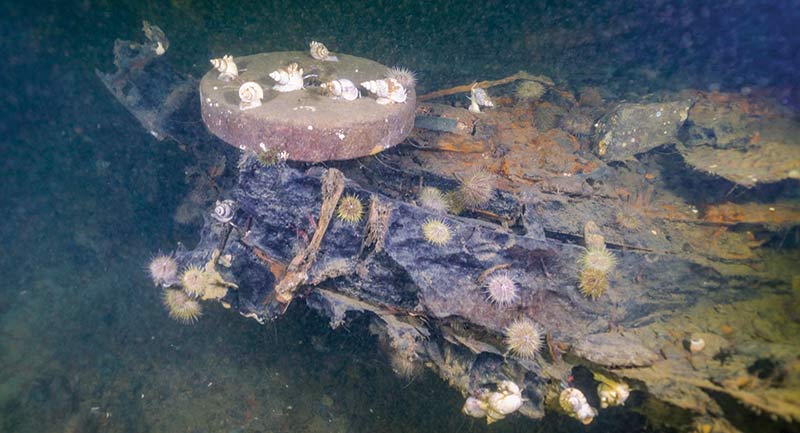Exploring the Unknown
Diving virgin shipwrecks of the treacherous St. Lawrence Estuary, where conditions change without notice…what could possibly go wrong?

Words by Kevin Brown and Sébastien Pelletier
Each year, two technical diving clubs – Les plongeurs d’épaves techniques du Québec (PETQ) and Plongeurs techniques de l’Outaouais (PTO) – get together to plan a joint expedition on a virgin shipwreck in the St. Lawrence Estuary. Last season we managed to visit two: the Donnacona No 1, in the vicinity of Saint-Jean-Port-Joli, and an unknown wreck near Rivière-du-Loup. Facing the unknown in cold water with powerful tidal currents means that sometimes things don’t go well. This story attests to the unexpected situations that can arise in this region.
The decision was made to dive the wrecks in July to maximize water temperature and reduce our chances of strong wind and fog, but the choices of dates were limited: the tide window is only adequate about one week per month.
Preparation took more than two weeks. Even then, we would still have to fill cylinders every evening and be willing to modify our equipment, because diving in this part of the river requires flexibility and a willingness to adapt and change.
The ten-day expedition did not start auspiciously. After arriving in Saint-Jean-Port-Joli, we had a few days extreme winds coming from the northeast. Those ‘Nordet’ winds run directly against the flow of the St. Lawrence, which results in the creation of hazardous waves. The first two days of diving were cancelled and two of the members had to go back home, taking their boat with them. This was unfortunate, as a second zodiac adds an additional layer of safety to an expedition; it is typically used for picking up any drifting divers who are blown from the wreck, or the line if it drifts due to a fast-rising tide causing heavy currents.
On the third day, the winds dropped just under the acceptable threshold to go out, although it would be a tight window. Because the marina did not have enough water at low tide, it was a race against time: if we were late, we could be stuck out in the estuary and risk running out of fuel or facing changing weather for the next six hours while we waited for the next tide. To compound the situation, the strong winds brought bigger waves that could force us to slow down our cruising speed. We finally left the marina – a bit late, since our captain, Sébastien Savignac, who had driven from Montreal that morning, had been caught in Québec City’s traffic. He’d had to work the day before.

On site
Upon arriving at the wreck’s coordinates, we scanned the entire site. Gathering this information was critical to ensure an efficient grappling of the wreck. After a long and challenging hooking operation, we managed to tie the rope to the zodiac. There was no time to waste since we were already at slack tide. Sébastien Pelletier was the first one to go in. His job was to secure the mooring onto the wreck and shoot the grappling hook back to the surface with his lift bag – that would be the cue to get in the water. Steve Doyon would follow and assist him. After a struggle fighting against the already strong current, he finally began his descent.
It was now Kevin Brown’s turn to dive: “I decided to leave my camera in the boat because of the rough weather; the water was brownish and, at best, we would have half a metre of visibility. Upon reaching the wreck, I realized that my drysuit was taking on water. I didn’t know where the leak came from – maybe a cut due to the sharp and rusty edge of the Donnacona No 1’s gunwale. I told myself that this was manageable since the plan called for a twenty-minute dive because we were already behind schedule. That was a mistake.
“On the wreck, we could observe the vestige of a cargo ship. After looking at the two strobes that marked the mooring line and identified the number of divers in the water, I understood that Sébastien was already out. Then, Steve began his ascent. I gave him a head start so that the captain did not have to manage two divers on the surface – he used a crane to winch the equipment back in the boat.

“Eight minutes later, I started to ascend, but the surface current picked up rapidly. Unable to hold on to the cable, I was immediately blown downstream. As I saw our boat disappearing over the horizon, I deployed my Surface Marker Buoy (SMB). After a long twenty minutes, the zodiac finally reappeared. Sébastien yelled that Steve would be picked up first since he was also drifting and making his way towards the shipping channel; something that hadn’t realized until this point. I kept drifting.
“Another fifteen minutes passed while they took care of Steve. Far away, between the waves, I saw the boat coming back, but this time not towards me. They were navigating in the wrong direction! It was only after the zodiac fully disappeared that it hit me: I was lost at sea. I waited for another fifteen minutes and hoped that they would come back. The waves were now acting like an almost permanent wall, I couldn’t see the shore anymore – they clearly couldn’t see my SMB. To make the matter worse, my drysuit was now fully flooded and I was drifting towards the shipping channel. Alone, surrounded by water, I made the decision to activate my Nautilus emergency radio beacon to signal my position to any boats in the area. I also launched my flare, which raised 100 feet (33m) above my head, illuminating the sky for a short moment. The time seems to slow down when you are helpless, waiting for a rescue. I wondered how long I would last with a flooded suit in cold water if my beacon did not work.
“Finally, after another fifteen minutes, the zodiac reappeared, cutting between two waves. Over the radio, our captain immediately cancelled the Search and Rescue helicopter that was getting ready to launch – I guess that the emergency signal reached the Coast Guard after all. However, the other divers confirmed that they never saw my flare; I was that far away.”
Some might say tech divers are paranoid for carrying all these safety gadgets, but during an expedition limits may be pushed, sometimes perhaps a bit too far. How the day would have ended without the emergency beacon, we don’t know. But Kevin’s outcome was better than that of our grappling hook, which was left bent by the force of nature.

Mystery wreck…
This incident did not dissuade us from undertaking the second part of our expedition: we had one more wreck to visit. After another dry day due to bad weather, we finally made it to our second target, near Rivière-du-Loup. Although it is less than 60 miles (100 km) away from our first site, the water conditions were completely different.
Again, we chose to dive at high tide, because it brings clearer ocean water, although colder. The grappling operation went smoothly since we were protected from the wind by an island. This time, Kevin was the first one to go in. Sébastien would follow soon after to help secure the mooring. After reaching the wreck, Kevin realized that the hull was made of wood; very exciting, because this meant that it was much older than originally thought. The incredible visibility allowed to see 33 feet (10m) in each direction; the water was crystal clear, although with a tint of green, as opposed to the total darkness we were expecting. The cargo hatch was filled with remnants of barrels, so this must have been a merchant ship. Far away, Sébastien flashed his light to signal that he found something interesting. As Kevin got closer, he could hear him trying to yell something through his regulator. Then, Sébastien pointed towards two massive jugs, still intact. But the time was up, so we ended the dive.
The second day on the wreck allowed us to search the deck further, where we discovered dishes, pulleys, and other artifacts. Soon after exiting the water, while assisting the captain in lifting the equipment with the crane, Kevin felt a pinch in his left shoulder. He knew what it was since he had suffered from the bends a few times before. As he got undressed, we could see the quarter-inch (6mm) swelling taking over his skin. To control the damage, Kevin went back on his rebreather on pure oxygen until we reached the marina. The symptoms diminished slightly, and he started to feel better. No need for a chamber ride.

…Identified!
The expedition ended without another incident. We all went home and began the process of identifying the wreck. Kevin also underwent surgery to patch his newly-discovered Patent Foramen Ovale – a small opening between the two upper chambers of the heart that may increase chances of decompression sickness.
By identifying the maker’s marks on the backs of the plates, we deduced that the wreckage took place after 1894. Based on newspapers articles and the rough timeframe, we were able to narrow our mystery ship to one of four. But only one was carrying barrels filled with fish: the SS Otter. We were happy to learn that there had been no loss of life when the SS Otter hit a shoal and sank on its way back from the Côte-Nord in direction of Québec City in November 1898.
Diving the St. Lawrence Estuary requires a willingness to adapt in order to explore its unique environment. It takes experience, boldness, and perseverance to be the first to reach a virgin shipwreck, and sometimes, the consequences can be unforgiving. A sudden fog, a rise in the wind or a tide change can significantly alter the plans. There are reasons why so many of those wrecks are still virgin.
Exploration team
PETQ
- Sébastien Pelletier
- Jean-Pierre Richard
- Sébastien Savignac
- Nathalie Lafrance
- David Tavares
- Claude Bureau Associate Member
- Sylvain Brunet Associate Member
PTO Exploration
- Kevin Brown
- Steve Doyon
Les plongeurs d’épaves techniques du Québec: www.facebook.com/PETduQuebec
Plongeurs techniques de l’Outaouais: www.facebook.com/PTOExploration
Additional information: www.patrimoine-culturel.gouv.qc.ca
Leave a Comment







